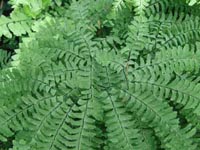Resource Library
Plant of the Week: Northern Maidenhair Fern
The University of Arkansas System Division of Agriculture does not promote, support or recommend plants featured in "Plant of the Week." Please consult your local Extension office for plants suitable for your region.
Plant of the Week
Northern Maidenhair Fern
Latin: Adiantum pedatum

Bad habits, I have a few, but then again, too few to mention. Well, except for maybe that E-Bay thing. Mine is a mild form of the affliction compared to some, but on occasion I find myself setting at the computer with a glazed look as I peruse the list of old books up for bid on the Internet auction site.
Last week, before I knew what had overcome me, I found myself bidding on an incredibly rich assortment of mid 19th century books on ferns, most illustrated with hand-colored wood block prints. Though my pocketbook doesn’t allow me to be a serious contender for such classics, it was fun to make the bottom feeders pay a fair price for the rarities.
These books were, according to the write-up of the seller, from an estate auction of someone with a passion for ferns. This passion for ferns is not a new thing, having reached its zenith during the Victorian era when no fewer than 20 books on fern growing and collection were published in England.
Of late, I have developed a keen interest in growing ferns. My dry hillside is hardly the ideal site for a fernery, but compared to the fern glen at the Dallas Botanic Garden where they have to resort to high-pressure foggers to keep the ferns alive, my site is relatively benign. Of all the hardy ferns, the maidenhair ferns are my favorites.
Maidenhair ferns are mostly a tropical genus with the greatest degree of speciation in the South American Andes. In North America, nine species are described but only two are common. The northern maidenhair (A. pedatum) is found in the eastern woodlands but is missing from the Gulf Coastal Plains. The southern maidenhair (A. capillus-veneris) occurs primarily in the Gulf Coastal Plains.
The two species are both deciduous and hardy throughout Arkansas. They have black, wiry stems and delicate, airy, shining, green triangular pinnae that curl under at the tip to protect a row of spores produced on the undersurface. In ferns, we talk of "fronds," not leaves. The frond is made up of subsets called "pinna," not leaflets.
Northern maidenhair fern grows up to 2 feet tall and several feet across, slowly spreading by means of a creeping rhizome that takes many years to get to the size of a saucer.
It's often seen growing on a hillside where the fronds cascade over in the very study of grace and beauty. The northern maidenhair frond is divided at the end in a "C" shaped branching pattern with the finger-like frond segments arising from the "C." The species epitaph means "like a bird’s foot," which roughly gives the look of the frond framework, at least as long as you have a good imagination.
Southern maidenhair is not as large with a feather-like frond with a linear arrangement with frond segments branching off of the central axis.
Understanding what drove the Victorians to pursue a generation-long passion for ferns - lasting from about 1840 to1870 - is challenging when judged against today’s standards of behavior. It grew out of the notion of what kinds of activities were "proper" for good, middle-class ladies.
Studying nature and making plant collections were officially sanctioned ladylike activities. The ladies began by collecting British ferns and pressing them into their books. But plants from around the globe were pouring into England at the time and soon the ladies - and it was primarily driven by the fairer sex - expanded their passion to embrace tropical ferns which could be grown in their parlors.
The northern maidenhair fern is easy to grow in the woodland garden, provided it is not too dry. It will grow in the same kind of environment favored by hostas. Fertile, rich sites produce larger plants than clayey banks, but it will grow in difficult sites too provided it has sufficient summertime moisture.
If additional plants are desired, divide the clump in early spring before the fronds emerge.
By: Gerald Klingaman, retired
Extension Horticulturist - Ornamentals
Extension News - May 28, 2004
The University of Arkansas System Division of Agriculture does not maintain lists of retail outlets where these plants can be purchased. Please check your local nursery or other retail outlets to ask about the availability of these plants for your growing area.